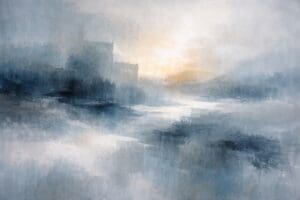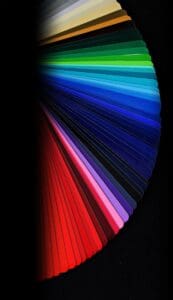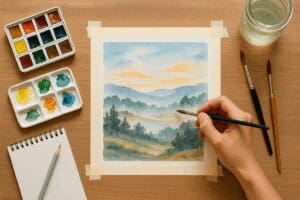Getting Started with Watercolors: Your Essential Guide
Watercolor painting is a delightful and accessible art form that invites both beginners and seasoned artists to explore creativity. Whether you’re drawn to its fluidity, transparency, or the soft, ethereal effects it can create, understanding the basic materials is essential for your watercolor journey. In this post, we’ll break down the necessary supplies, including paints, brushes, paper, and palettes, and provide you with tips to get started.
1. Watercolor Paints
Types of Watercolor Paints
Watercolor paints come in two primary forms: tubes and pans.
- Tubes: These are concentrated pigments in a creamy consistency. They’re ideal for larger washes and mixing, offering vibrant color straight from the tube.
- Pans: These are solid blocks of paint that need to be activated with water. They’re portable and perfect for travel or quick sketches.
Recommended Brands
Some reputable brands include:
- Winsor & Newton: Known for high-quality pigments and a wide range of colors.
- Daniel Smith: Offers unique pigments, including earth tones and iridescent options.
- Sennelier: Features honey-based watercolors that remain vibrant and workable.
Where to Buy: You can find quality watercolor paints at local art supply stores or online retailers like Dick Blick and Jackson’s Art Supplies.
2. Brushes
Choosing the right brushes is crucial for achieving various techniques and effects in watercolor. Brushes vary by shape, size, and bristle type.
Types of Brushes
- Round Brushes: Versatile for detail and washes. Look for sizes ranging from 0 to 12.
- Flat Brushes: Great for broad washes and sharp edges.
- Mop Brushes: Ideal for large areas and soft blending.
Recommended Brands
Consider brushes from:
- Escoda: Known for their high-quality synthetic and natural hair options.
- Princeton: Offers affordable and durable synthetic brushes.
3. Paper
Watercolor paper is specifically designed to handle the water and pigments used in painting. It’s thicker than regular paper and comes in various textures and weights.
Types of Watercolor Paper
- Hot Press (Smooth): Ideal for fine details and smooth washes.
- Cold Press (Not rough): Offers texture for more expressive brushwork.
- Rough: Best for bold, textured effects.
Weight
Look for paper with a weight of at least 200 gsm (grams per square meter) to prevent warping.
Recommended Brands
Popular options include:
- Arches: Renowned for its quality and durability.
- Canson: Offers affordable options suitable for beginners.
4. Palettes
A good palette is essential for mixing colors. You can choose between a traditional ceramic palette or a plastic one with wells.
Features to Look For
- Size: Make sure it has enough wells for mixing various colors.
- Material: A smooth surface is preferred for easy cleaning.
Recommended Brands
Consider palettes from:
- Kuretake: Offers portable options perfect for plein air painting.
- Winsor & Newton: Their palettes are durable and easy to clean.
5. Additional Tools
Besides the primary materials, a few additional tools can enhance your watercolor experience:
- Masking Tape: To tape down your paper and create clean edges.
- Water Container: For rinsing brushes and diluting paints.
- Paper Towels or Rags: Useful for blotting excess water and cleaning brushes.
6. Getting Started: Basic Techniques
Once you have your materials, it’s time to explore some basic watercolor techniques:
- Wet-on-Wet: Apply wet paint to wet paper for soft, diffused edges.
- Wet-on-Dry: Apply wet paint to dry paper for sharper lines.
- Lifting: Use a damp brush or paper towel to lift pigment from the paper.
- Glazing: Layer transparent washes to create depth and richness.
7. Practice Makes Perfect
Start with simple exercises, such as painting washes or experimenting with color mixing. Gradually move to more complex subjects as you gain confidence.
Conclusion
Watercolor painting is an enjoyable and rewarding medium. By selecting the right materials and practicing fundamental techniques, you can create beautiful works of art. Whether you’re painting landscapes, florals, or abstract compositions, the key is to experiment and have fun.
Useful Links:
By gathering the right materials and diving into the practice, you’ll soon find yourself creating your own watercolor masterpieces. Happy painting!
*For collaborations, art features, or inquiries, please contact us at [email protected]. Don’t forget to follow us on Instagram, Facebook, Twitter.
Disclaimer: The views and opinions expressed in this article do not necessarily reflect the official policy or position of Irish Artmart.
Irish Artmart – Your Gateway to Artistic Excellence.
Tips to Express Your Creative Vision – Irish Artmart Podcast




